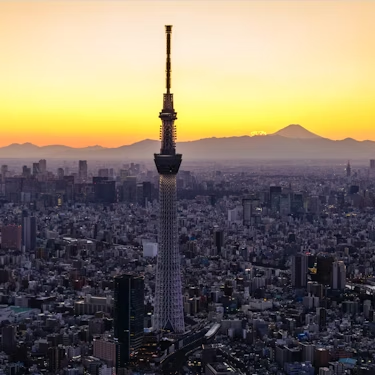More about: Best Things To Do In Tokyo In 5 Days
Tokyo is the largest city in the world, which can be intimidating for any traveller!... And if you add other frontiers like the language, the rules of coexistence and so many other things that are part of the culture, it can be scary.
Don't worry! You are not the first one who has had that feeling and, fortunately, there are many tools to "survive" as a tourist in the Japanese city and enjoy everything there is to see and do in Tokyo. In this post I'll give you some recommendations for tours and tips on how to make the most of those 5 days. Let's get started!
1. Day A first bike ride around the city and end the day with a well-deserved dinner.

To start your first day in this mega-city with all your energy, I suggest you start with a bike ride. The idea is that after all that pedalling, you'll have enough appetite for a delicious gastronomic tour of Tokyo and end the day with a good taste in your mouth. What do you think?
Bike, helmet and pedal through the city
Although the Japanese capital is huge and intimidating, cycling is an efficient and friendly way to get around. There is little hilly terrain, the traffic is very respectful and many of the sights are best enjoyed without a window in between.
It will be easy to admire the iconic scenes of the city on a bike, such as the giant skyscrapers that loom over Shinjuku and Meiji-jingu, a famous religious site in the city.
Other places to visit include the Aoyama Cemetery, a very old cemetery with the grave of a famous and faithful Japanese canine, the beautiful Buddhist temple of Zōjō-ji and the Aqua City Odaiba shopping complex.
This tour departs just a few steps from the New National Theater. To get there by public transport, the best option is to take the Keio New Line to Hatsudai Station, located in front of the theatre.
By the way, all the visits and tours I recommend in this post can be easily reached by public transport. I will provide you with the easiest routes.
And then... A delicious dinner
After almost 7 hours of exercise, you'll definitely want to relax and fill your stomach. So get ready for a date where food will be the main thing.
I invite you to take a food tour of Tokyo to see the most popular izakaya spots, a word that translates into English as "a place to have a drink and make yourself comfortable."
One of the classic stops is the labyrinthine Omoide Yokocho area. Here, many small traditional restaurants saturate the alleyways to offer one of the most popular dishes: yakitori.
Also, less than 7 blocks away is Golden Gai, a neighbourhood that will make you feel like you have stepped back in time and is a popular part of Tokyo's nightlife. The area is home to a multitude of small bars, food stalls and karaoke bars.
The meeting point for this tour is at Shinjuku Station, one of the busiest stations in all of Tokyo, served by 12 different train lines, operated by 5 different companies. So if you plan to arrive by public transport, you'll be spoilt for choice.
An easy way to get there is to take the Marunouchi line of the underground service.
2. Day A tailor-made daytime tour and nighttime escape to Shibuya
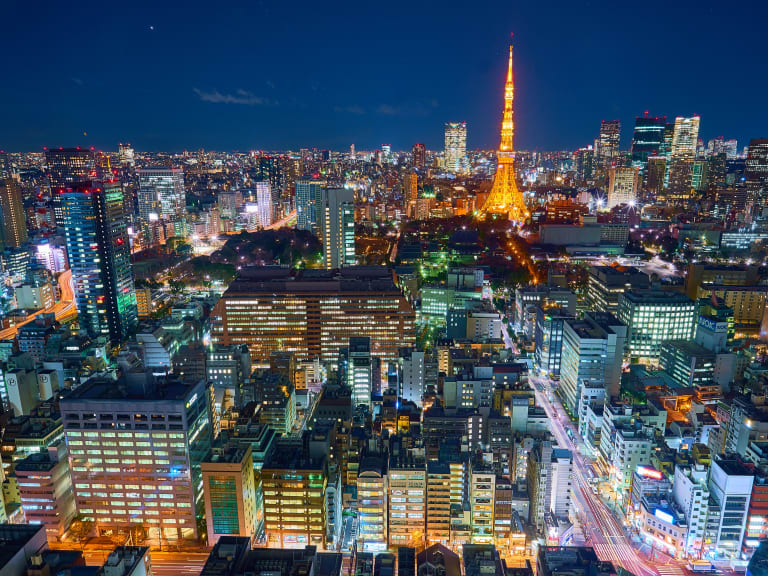
On this, your second day in the world's greatest city, you'll take a more leisurely itinerary. Well, you'll determine the pace, because you'll be doing it at your own pace.
A private car with chauffeur guide is a very comfortable way to visit different attractions in a small group. Later, you'll end the day with a nightlife break in Shibuya. You'll love it.
You choose where to go and aboard a comfortable car
Just as you read it. The great thing about this tour is that all you have to worry about is setting your own schedule and the destinations you want to see in Tokyo.
Although you will be provided with suggestions of pre-set routes, it's up to you to choose, adapt or take a completely different route. Plus, you determine how much time you want to spend at each attraction, something you've often wished for on a tour, right?
What do you want to visit? Buddhist temples? Imperial Palace Gardens? Edo Museum? or a modern district? It's up to you! And don't forget to add places to shop, stop for a bite to eat or whatever else you want to do to pass the time on the streets of Tokyo. It's all included in the tour, which can take up to 9 hours.
Simply a perfect way to spend the day at different attractions and fit in with your schedule.
Visiting Shibuya Ward
On the way back, you'll want to take a couple of hours to rest at the hotel, because in the evening you'll find a neighbourhood that will catch your attention: Shibuya.
Shibuya is one of Tokyo's special neighbourhoods and a must on every visitor's itinerary.
You may have heard of it because of the Shibuya crossing, an intersection where, every time the traffic lights open, a massive human tide invades the asphalt. It has been estimated that at rush hour, up to three thousand people can cross the intersection in a single shift.
You can come and be part of the crowds crossing it, or you can watch this scene from above at the Starbucks in the Tsutaya building, which is located to the north of the crossing.
You can easily get to Shibuya and this particular crossing from anywhere in the city via the Ginza, Hanzomon and Fukutoshin underground lines. If you can't find your way around, look for the Hachiko statue and you'll know you're in the right place.
Being a very trendy and touristy neighbourhood, you'll find plenty to eat here, just around the station alone , there are several restaurant options.
Fashion and shopping
The night is long here. And if you like shopping, Shibuya has plenty of options within walking distance. Enter the 109 shopping mall, located just a few steps from the station to get an idea. If Japanese fashion doesn't quite do it for you, you'll find shops of many familiar Western brands nearby.
Speaking of fashion, this part of the city is where the latest trends are cooked up, making it one of the most fashionable districts in Tokyo. With a brief stroll through its streets, you'll find all kinds of proposals in clothing, hairstyles and everything that makes you stand out from the crowd.
Need to see more? Check out Harajuku
If you think you've seen it all, I invite you to its neighbour Harajuku, located one stop away (Harajuku station) on the Yamanote line of the Japan Rail (JR). It won't take you more than 5 minutes to get there.
Everything you couldn't see in Shibuya, you'll find here. From cosplayers to punk musicians, to gothic lolitas and many other urban tribes you didn't even know existed.
Feeling the rhythm of this great city in one of its most modern and creative spaces will definitely be an experience you will enjoy from beginning to end.
3. Day Getting to know the surroundings of Mount Fuji and spectacular night shots of the city.
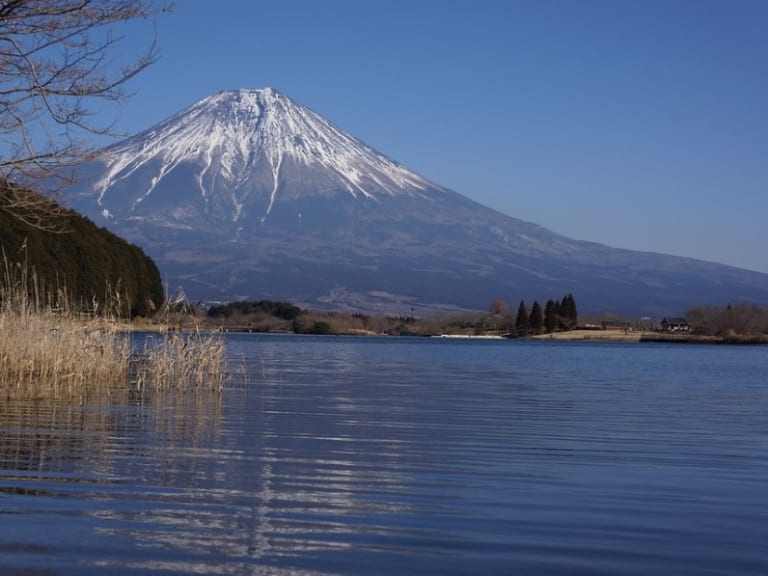
On the third day, you'll spend a few hours in nature. It seems difficult with such a massive metropolis, but yes, it's possible and it's not far away.
The destination? The landscapes at the base of Mount Fuji, an active volcano that is also the most revered sacred mountain in Japan. On your return to the city, if you bring a professional camera, even better, because you'll go on a night photography tour.
Mount Fuji and its icy caves
Many years ago, an eruption of the volcano (Mount Fuji) spewed boiling lava down the slopes of the Aokigahara Forest and penetrated the ground, creating caves. Later, the snow that covers this volcano half the year entered the caves and today they are fascinating caves that are well worth visiting.
The best way to visit these caves is with an organised tour to Mount Fuji, where you will be guided through the interior with all the professional instruction for a safe and fun tour.
To start this tour, one of the pick-up points is Kawaguchiko Station. To get there by public transport, take the Japan Rail (RL) Chuo Line from Shinjuku Station(which is served by the Marunouchi Line) to Otsuki Station.
Once there, transfer to the Fujikyu line which will take you to Kawaguchiko station. The transfer will be a long one, so at Shinjuku Station you can either have breakfast or buy something to take with you.
Trying your hand at photography in the city
When you return to Tokyo, you may want to rest a bit at the hotel before continuing your day's sightseeing. The world's largest city never sleeps...and it's quite a light show at night that's worth getting out to look at through a photographic lens.
Whether you're a beginner or a professional photographer, if you love photography and want to get the best night scenes of the city, you'll love this tour.
This photo tour of Tokyo takes you through iconic areas of the city such as Shinjuku and Shibuya to get the most out of your camera.
Even if you've been to these neighbourhoods before, this tour will take you to off-the-beaten-path spots and give you the instruction you need to capture all sorts of urban scenes in your own style.
You'll have 2.5 hours to use up your camera's memory! Conveniently, the departure and return point of the tour is Shinjuku Station, which is well connected to the city's various train and underground transport lines.
4. Day The traditions of Ningyocho and Nihonbashi by day, before jumping into the ultimate modernity at SkyTree by night
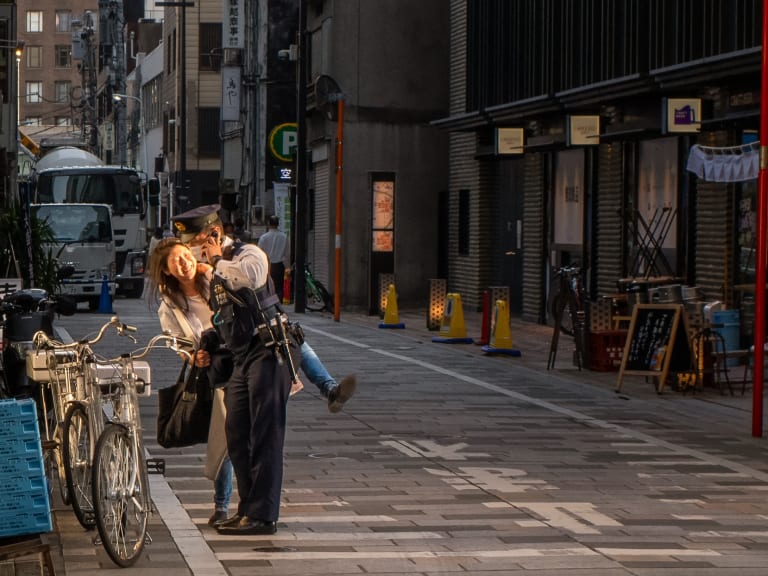
On the fourth day of your trip, how about starting with a relaxing tour of a traditional Edo-period neighbourhood ? Its quiet streets and shops that have been offering goods and services to the community for hundreds of years will captivate you.
In the afternoon, I suggest you move to SkyTree and the modern shopping area that surrounds it. You will be amazed at how these contrasts between the modern and the old are maintained in one city.
Discovering a few corners of old Tokyo
Ningyocho ward is part of the Nihonbashique district. During the Edo period, it was a prominent entertainment district where puppet theatres (Ningyocho means "dolls") abounded. Today, it is a very attractive historical area, as the locals have chosen to survive by maintaining the traditions and pace of life of several centuries ago.
It is a charming neighbourhood. Carefully handcrafted typical objects and dishes that are prepared as if they were a work of art are what you will see here.
If you choose to take this tour with an expert guide, you will do some sightseeing to learn about the history of Ningyocho, but you will also hear the story of what some locals have lived through for generations. You will be amazed to see how there are warehouses selling the same product for almost three centuries.
The meeting point is usually very close to Ningyocho underground station, which you can reach via the Hibiya line of the underground.
Visit to Japan's tallest tower: Skytree
You're almost at the end of your trip and, if you didn't include it in your personalised driving tour, there's still time to visit one of Tokyo's must-see attractions: the Skytree.
The advantage is that it is very close to your first walk, you only have to re-enter Ningyocho station and take the Hanzomon underground line to the last station: Oshiage.
This tower is one of the most visited viewpoints in Tokyo. It was inaugurated in 2012 and, at 634 m high, was recognised as the tallest in the world. However, this distinction only lasted a few months when the Burj Khalifa tower in Dubai was unveiled to the world at 828 metres high. That doesn't take away from the extraordinary nature of the Skytree, and it's a site no tourist wants to miss on their visit to Tokyo.
You'll find two observation decks, one at 350m (Tembo Platform) and the other at 450m (Tembo Gallery). The interesting thing about climbing the Tembo Platform is that it has some glass-floored areas to add to the experience. But the most spectacular views are definitely in the Tembo Gallery.
Skytree tickets and more to see here
Going up to the first platform will cost you approximately 13 euros and the package to enter both platforms together will cost you an average of 20 euros. It's really not much of a difference, so if you have the possibility, I would suggest you buy tickets for both. You can buy tickets here.
The Skytree is the central part of a huge urban development called Tokyo Sky Tree Town. Its attractions include a shopping mall and an almost 30-storey office building, but in my opinion, the most incredible thing is the presence of an aquarium and a planetarium as well.
5. Day And I hope you're a fan because... Anime is a must on a visit to Japan!
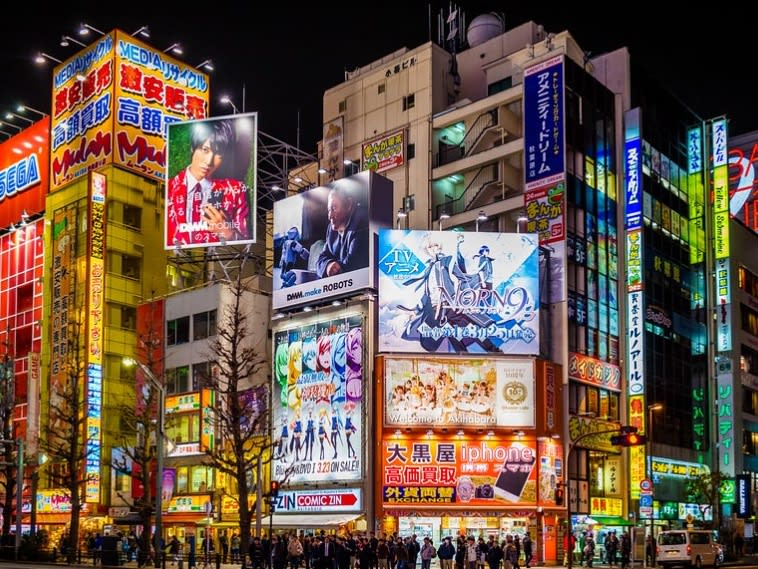
That's right, I had to dedicate a day to anime because few things are as Japanese and as well known all over the world as this art form. In addition to the many shops and products that you will have seen throughout the city during your stay, there are museums and spaces dedicated solely to anime.
Here are three options for you to choose where to spend the day, because besides the fact that they are too far apart to visit all three (possibly two, if you adjust), in each one you will find much more than you can imagine. Come on!
Get lost in the pop culture paradise of Akihabara
With its origins as a post-war black market, Akihabara eventually became **Japan'**s must-see technology showcase, with thousands of shops selling all manner of electronics and cutting-edge technology.
In recent years, it has earned its place as a haven and paradise for fans of video games, manga and of course anime.
In Akihabara, a must visit is the Akiba Cultures Zone, a 5-storey building where you will find everything! about Japanese pop culture, from figurines and comics, to movies, collectible cards, toys and all kinds of costumes for cosplay.
Other shops I recommend you visit are: Animate, the largest anime, video game and manga shop in Japan with more than 100 physical shops in the country and, if you are more into building and constructing, the Kotobukiya shop is an excellent option and also has affordable prices on a regular basis.
Not all comics and manga in Akihabara
Although anime shops outnumber tech shops, there are still plenty of shops selling cables, circuit boards and other parts you might be looking for. It is also not hard to find shops offering used and repaired computers at very affordable prices. The same goes for mobile phones.
Without a doubt, one of the best places to buy souvenirs from Japan is Akihabara. And as you may have seen, if anime or other elements of Japanese pop culture are not your thing, you might as well go here for other types of shopping.
To get to Akihabara by public transport, a quick way is to go to Shinjuku Station, and from there take the Japan Rail (JR) Sobu line to Akihabara Station. All the shops I have recommended are less than 2 streets away from each other.
Ghibli Museum
If you grew up with My Neighbour Totoro, Porco Rosso or Spirited Away... you probably know what I'm talking about and your emotions are already running high. Yes! In Tokyo you will find a museum dedicated to the Ghibli Studios, which produced these and other enchanting animated stories that stole the hearts of millions around the world.
One of the museum's objectives is to show the whole process of making an animation, from the moment an idea is conceived until it is projected to the world. There are several rooms where inspiration, creativity, artistic talent and fun will steal your breath away.
Oh, and don't forget to stop by the Mamma Aiuto souvenir shop !
This museum is located inside Inokashira Park. A quick and familiar way (yes, again, from Shinjuku station) is to take the JR Chuo line and get off at Kichijoji. Then walk three blocks south and you'll soon be in the park. I recommend you not to be in a hurry, so you will enjoy this beautiful park better.
Nakano Broadway
The Nakano neighbourhood is another popular area for manga, anime and collectors. Here you will find Nakano Broadway, a huge three-storey shopping mall dedicated to Japanese pop culture.
However, the difference with the others I have recommended is that here you will also find temples and shrines immersed in beautiful parks, traditional alleyways and other elements to contemplate.
Another advantage of visiting it is that it is very close to Shinjuku Station. You can get there via the JR Chuo Line to Nakano Station. Nakano Broadway is a five-minute walk from the north exit of the station.
Some final recommendations

- Before booking, make sure you check the language of the tour guide. English is still one of the first choices for sightseeing in this country, although Spanish is also gaining popularity.
- For the personalised driving tour, check carefully which places you want to visit on your dream trip to Tokyo and compare it with the standardised tours... but above all, be open to suggestions, as they know their city best.
- Perhaps you should know that Tokyo and Japanese culture in general is very given to courtesy, order and respect, where following certain guidelines is necessary to avoid attracting (bad) attention.
- I have left you some connections for public transport. In Tokyo, this is the basic means of transport and one of the most efficient in the world. Make the most of it. Once you arrive for the first time at Shinjuku Station and make your first trip, everything will be easier.
The whole itinerary at a glance
- Day 1
- City bike tour and izakaya food tour in the evening
- Bicycle tour: from 66 €. Evening food tour: from €165.
- Second day
- Private car tour of the city and one night in Shibuya
- Driving tour: from €481. Shibuya night outing: suggestion to do on your own.
- Day 3
- Excursion to the Mount Fuji region and a night photo tour of Tokyo.
- Mount Fuji: from €55. Night photo tour: from €161.
- Fourth day
- Excursion to traditional Ningyocho and SkyTree area
- Excursion to Ningyocho: from 47 euros. SkyTree tour: from €13 to €20 for entrance to the tower.
- Fifth day
- Museums, neighbourhoods and shopping centres related to Japanese Anime and Pop culture (various options).



